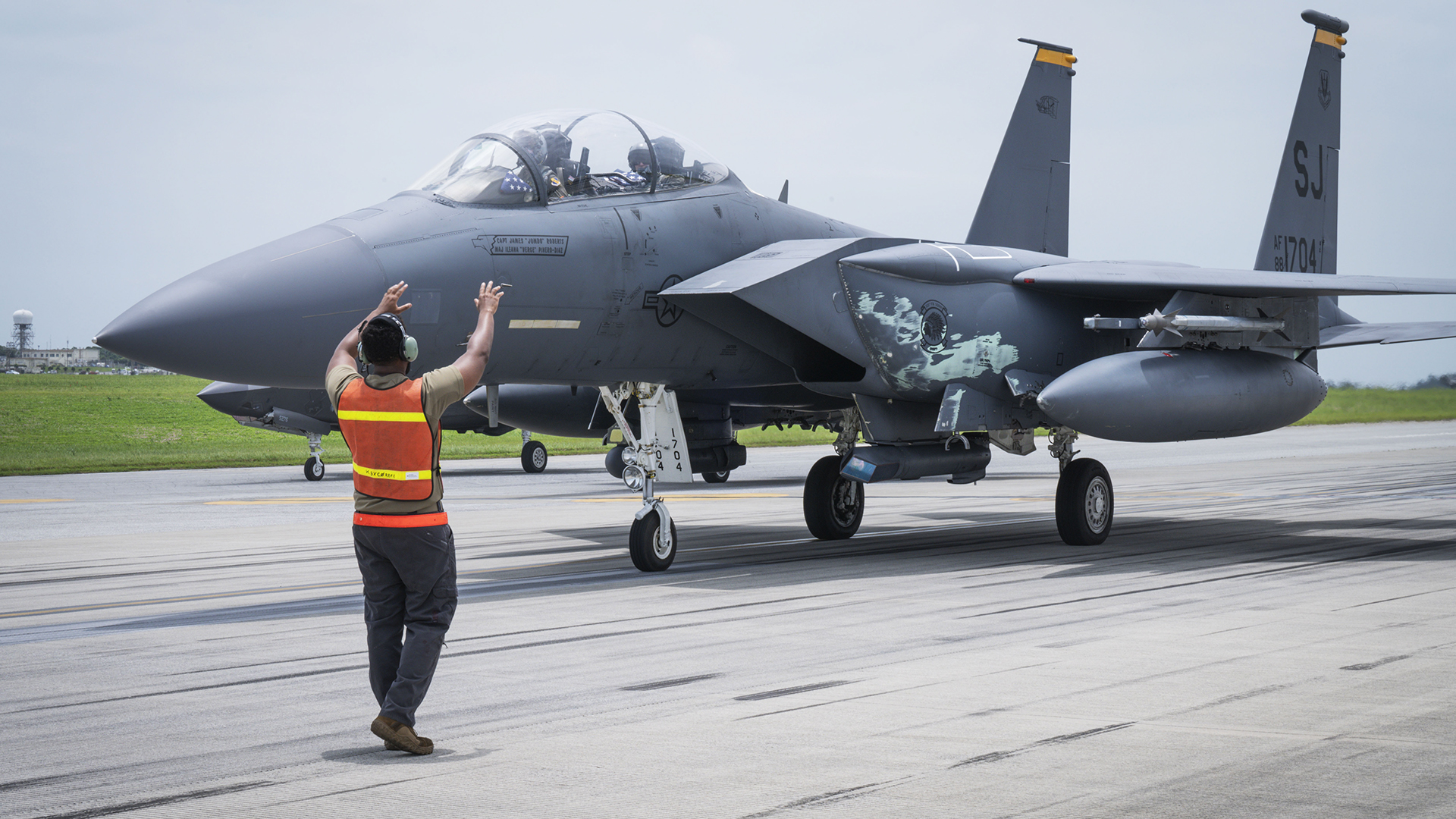The U.S. Air Force has increased the number of F-15s sent to Diego Garcia to provide force protection, a U.S. defense official has confirmed to The War Zone. The fighters are there to defend the island and the bomber contingent that has called it home for nearly two months now amid rising tensions with Iran. During America’s accelerated bombing campaign of the Houthis in Yemen, B-2s arrived at Diego Garcia and have since been replaced by B-52s. You can read more about the initial arrival of the F-15s and why they were sent there in our exclusive story here.
“There are now six F-15Es on the island,” said the official, speaking on condition of anonymity to discuss operational details.
The official’s comments are in line with new satellite imagery reviewed by The War Zone. Last week, we were the first to report on the arrival of F-15s on the remote island. There were four Strike Eagles visible on Diego Garcia when we first noted fighters at the base in an archived Planet Labs satellite image of the island taken on May 16, 2025. Low resolution imagery taken today indicated that at least two more had arrived.
While the official declined to say where the jets came from, open source trackers state the jets arrived from Kadena Air Base in Okinawa, Japan, located nearly 4,400 miles from Diego Garcia.
Last month, a contingent of F-15Es from the 336th Fighter Squadron (FS) at Seymour Johnson Air Force Base in North Carolina forward-deployed to Kadena.
Officials at Seymour Johnson declined to comment on whether the Strike Eagles on Diego Garcia are from the 336th FS. However, their forward presence at Kadena would facilitate an ACE force protection mission to a remote island like the one currently underway.

“As the Keystone of the Pacific, Kadena is a pivotal hub for Agile Combat Employment (ACE),” the Air Force wrote in a press release last month announcing the arrival of jets from the 336th, also known as the Rocketeers. “The 18th Wing will continue to receive rotational units that strengthen capabilities, such as ACE, and project combat power in concert with allies and partners.”
ACE is a term that currently refers to a set of concepts for distributed and disaggregated operations centered heavily on short notice and otherwise irregular deployments, often to remote, austere, or otherwise non-traditional locales.
As we have previously noted, “Diego Garcia has long been a highly strategic operating location for the U.S. military. Beyond its large airfield that sits in the center of the Indian Ocean, it plays many roles for the Department of Defense, including hosting Space Force operations, serving as a key port for U.S. Navy vessels, including nuclear submarines, and its lagoon provides shelter for a Sealift Command Prepositioning Ship Squadron.”

Historically, Diego Garcia’s remote location has served as a natural barrier to attack by non-near-peer potential adversaries like Iran. However, the threats have been evolving — particularly in the form of long-range attack drones and missiles — and The War Zone previously raised the question of whether fighters like Strike Eagles would be needed to protect the island and its bomber guests. The multi-role F-15Es are particularly well-suited for that role. You can read more about this in our story here.
In addition to the Strike Eagles, The War Zone also noted that there were four B-52H bombers, five KC-135 tankers, a C-17 cargo plane, and a white-colored airliner with orange nacelles — most likely an SAS airlines personnel transport flight seen in the image taken May 16. The low-resolution image we saw today shows the B-52s are still there, along with three KC-135s and the C-17, as well as the six fighters.
Earlier, the island gained a lot of attention for hosting an unusually large force of six B-2 Spirit stealth bombers that began arriving in March for a clear show of force aimed primarily at Iran. The B-2s subsequently conducted strikes on Iranian-backed Houthi militants in Yemen.
For a short period, there were 10 U.S. Air Force bombers on Diego Garcia, however, the B-2s began leaving about May 9th. Earlier today, Whiteman Air Force Base posted a video of the Spirits returning.
“You can’t fight what you can’t see,” Whiteman said on X. “#B2Spirit stealth bombers returned home to Whiteman AFB from a deployment to Diego Garcia, British Indian Ocean Territory.”
It is unknown if additional Strike Eagles will be headed to Diego Garcia or how long the ones there now will remain. We will provide updates when warranted.
Contact the author: howard@thewarzone.com
